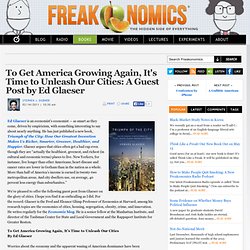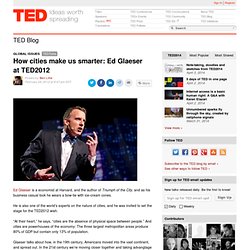

Pam Warhurst: How we can eat our landscapes. Urbanization and Global Change. Global Urban Population in Developed and Developing Countries The human population has lived a rural lifestyle through most of history.

The world’s population, however, is quickly becoming urbanized as people migrate to the cities. Figure 1 shows the urban population growth between 1950 and the year 2000. In 1950, less than 30% of the world’s population lived in cities. This number grew to 47% in the year 2000 (2.8 billion people), and it is expected to grow to 60% by the year 2025. Developed nations have a higher percentage of urban residents than less developed countries. The definition of an urban area changes from country to country. Cities with over 5 million inhabitants are known as megacities. Why is the urban population increasing so fast? The rapid growth of urban areas is the result of two factors: natural increase in population (excess of births over deaths), and migration to urban areas. Other policies reinforce the above scenario.
To Get America Growing Again, It's Time to Unleash Our Cities: A Guest Post by Ed Glaeser. Ed Glaeser is an economist’s economist — as smart as they come, driven by empiricism, with something interesting to say about nearly anything.

He has just published a new book, Triumph of the City: How Our Greatest Invention Makes Us Richer, Smarter, Greener, Healthier, and Happier. Glaeser argues that cities often get a bad rap even though they are “actually the healthiest, greenest, and richest (in cultural and economic terms) places to live. New Yorkers, for instance, live longer than other Americans; heart disease and cancer rates are lower in Gotham than in the nation as a whole. More than half of America’s income is earned in twenty-two metropolitan areas. And city dwellers use, on average, 40 percent less energy than suburbanites.”
We’re pleased to offer the following guest post from Glaeser on the glory of cities. Cities are people, not structures. The world is flat — except for the brilliant peaks that we build together in our cities.?? How cities make us smarter: Ed Glaeser at TED2012. Ed Glaeser is a economist at Harvard, and the author of Triumph of the City, and as his business casual look he wears a bow-tie with ice-cream cones.

He is also one of the world’s experts on the nature of cities, and he was invited to set the stage for the TED2012 wish. “At their heart,” he says, “cities are the absence of physical space between people.” And cities are powerhouses of the economy: The three largest metropolitan areas produce 80% of GDP but contain only 13% of population. Glaeser talks about how, in the 19th century, Americans moved into the vast continent, and spread out.
In the 21st century we’re moving closer together and taking advangtage of the benefits of being close to each other, and cities are growing tremendously. More than half of humanity now lives in cities, and it’s been incredible successful. All of that decline was because it looked like cities had lost their economic reason for being: Transportation. The other real problem, was urban sprawl. Urbanization. Origin of Cities: Some Introductory Points The City is a relatively recent form of social organization.

Homo sapiens, the present human form has existed on earth for about 200,000 years, but cities have existed for less than 10,000 years. Jericho in about 7000 B.C. grew from village to a "city" of about 3,000 3,500-4,000 B.C. first large cities (population of about 25,000) were established in Mesopotamia. A "city" refers to a place of relatively dense settlement -- dense enough so that city residents can not grow their own food. A city population, therefore, is always dependent upon its "hinterlands" to provide it with food. Cities and growth: Lump together and like it. How Should We Be Thinking About Urbanization? A Freakonomics Quorum. Urbanization has been climbing steadily of late, with more than half of the world’s population now living in cities.

Given the economic, sociological, political, and environmental ramifications, how should we be thinking about this? We gathered a quorum of smart thinkers on this subject — James Howard Kunstler, Edward Glaeser, Robert Bruegmann, Dolores Hayden, and Alan Berube — and posed to them the following questions: This year marked the first time in human history that more people lived in cities than in rural areas. What problems and opportunities does this present? What effects has it had on our local and global culture? Thanks to all of them for participating.
I hope you enjoy all of our guests’ comments as much as I did. James Howard Kunstler, author of The Long Emergency and The Geography of Nowhere: Most observers tend to extrapolate current trends and assume that what we see now will continue moving in the same direction — ever-larger cities, etc. Cities And The Environment.